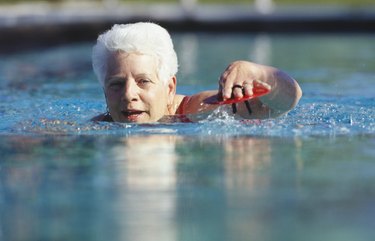
Cardio for seniors should center around low-impact, safe forms of exercise. Tone down the intensity of your workouts by using gentler alternatives. For example, you can swap running on the treadmill for walking.
Types of Senior Workouts
Video of the Day
While cardio exercises are important for seniors, all forms of exercise are helpful. A June 2016 study published in the International Journal of Clinical Practice found that a multicomponent exercise program gives seniors the most benefit.
Video of the Day
The researchers looked at studies that combined different forms of exercise into one program. There were strength, endurance, flexibility and balance exercises included. When combining different forms of exercise, the benefits were even more profound than when doing just one type of exercise.
They have found that seniors were able to reduce their risk of falling and enjoy a better quality of life. Their cardiovascular endurance increased too. Furthermore, they dropped body fat and improved their cholesterol levels. Cognitive function also improved.
While you should include multiple types of exercise in a program for seniors, cardio is necessary and can be tricky to do. Many forms of exercise that younger people enjoy, such as running or playing sports, can be dangerous for seniors. For that reason, you should consider safer options.
The American Academy of Family Physicians recommends getting two hours and 30 minutes of cardiovascular exercise per week for seniors. This can be broken up over multiple days, or you can do a little bit every day. Another option is to do vigorous exercise, such as jogging, for one hour and 15 minutes a week.
According to the U.S. National Library of Medicine, there are many benefits to exercising regularly. You may lose weight, lower your risk for heart disease, cut cancer risk, control blood sugar levels and enjoy better sleep.
Cardio for Seniors
The Centers for Disease Control and Prevention (CDC) recommend staying as active as your body allows. They advocate for sitting less and moving more since the benefits of exercise are so numerous. If you do over 300 minutes of moderate-intensity aerobic exercise per week, the benefits are even greater.
You can classify the intensity of your workout on a scale of 1 to 10, with 1 being the easiest and 10 being the hardest, explains the CDC. Moderate intensity should be a 5 or 6 on the scale. Vigorous exercise is a 7 or 8 on the intensity scale. Aim for exercises that keep you in the 5 or 6 range and remember that intensity is relative to each person.
Read more: At-Home Workouts for Seniors to Improve Balance, Mobility and Strength in Your 60s and Beyond
Walking is a safe and easy-to-use form of cardio for seniors. It's easy to get out and go for a walk, you don't need equipment and there's no special technique. The National Institute on Aging suggests walking in a mall for exercise.
When you walk in a mall, there aren't as many environmental factors as outdoors. You don't have to worry about sunburns, pouring rain, snow or wind gusts. It's a controlled environment that you can use as long as it's open. You can gather your friends and go, or do it alone.
Strength Training for Seniors
The benefits of aerobic training for seniors are clear. However, that doesn't mean that you should only do cardio. Adding weight training to your routine can help them build muscle and get stronger.
According to an August 2019 review published in the Journal of Strength and Conditioning Research, strength training can significantly improve overall health in older adults. A decreased risk of disease, longer life expectancy and feelings of well-being are just a few of its many benefits.
To be safe, seniors should seek professional help when starting a weight training program. A personal trainer can show you proper form and help you avoid injuries. You can also take an exercise class that specializes in strength training.
Fit & Strong, for example, is a program designed for seniors and incorporates multiple forms of exercise. The group class incorporates flexibility, resistance training and walking, all in a single program. It was recognized by the American Society on Aging as an award-winning, evidence-based exercise program.
Swimming for Seniors
According to a May 2019 article from Swim England, swimming is an activity you can do for life. It's low impact and safe for your joints, making it easier to maintain your fitness and conditioning.
As a form of exercise, swimming has many of the same benefits as other cardiovascular activities, helping seniors live longer, healthier lives. The only drawbacks are that you need access to a pool and the ability to swim. You may also try water aerobic exercises, which don't necessarily require swimming.
Using a group exercise class or swimming instructor can ensure your safety and boost your motivation to work out. Some group exercise classes in the water incorporate dance and other fun movements that will lift your mood.
The Arthritis Foundation Aquatic Program has a water-based group exercise program, according to the Centers for Disease Control and Prevention. The program may increase your range of motion, strength, aerobic fitness and even personal confidence.
- Centers for Disease Control and Prevention: "Arthritis Foundation Aquatic Program (AFAP)"
- Fit & Strong: "Welcome to Fit & Strong"
- National Institute on Aging: "Mall Walking"
- Centers for Disease Control and Prevention: "How Much Physical Activity Do Older Adults Need?"
- U.S. National Library of Medicine: "Benefits of Exercise"
- American Academy of Family Physicians: "Exercise and Seniors"
- International Journal of Clinical Practice: "Health Benefits of Multicomponent Training Programmes in Seniors: A Systematic Review"
- Journal of Strength and Conditioning Research: "Resistance Training for Older Adults"
- Swim England: "Swim England Release of Fact Sheets to Highlight Health Benefits of Swimming"
Is this an emergency? If you are experiencing serious medical symptoms, please see the National Library of Medicine’s list of signs you need emergency medical attention or call 911.